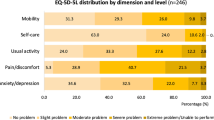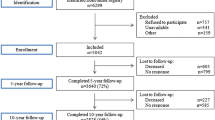Abstract
Objective
To investigate the quality of life (QOL) of cancer pain patients in Beijing, and explore the effect of cancer pain control on patients’ QOL.
Methods
Self-developed demographic questionnaire, numeric rating scale and SF-36 questionnaire were used together among 643 cancer pain patients in 28 Grade 2nd to 3rd general hospitals and 2 Grade 3rd cancer hospitals.
Results
The SF-36 eight dimensions scores ranged from 31.75 to 57.22 in these cancer pain patients. The t test and Wilcoxon rank sum test were used to compare the QOL between pain controlled (PC) group and pain uncontrolled (PUC) group, and the results showed that patients in PC group had the higher QOL scores in 6 areas of SF-36 (P<0.05). Binary logistic regression results found that pain management satisfaction scores (P<0.001), family average personal monthly income (P=0.029), current receiving chemotherapy (P=0.009) and cancer stage (P<0.001) were the predictors to cancer pain controlled results.
Conclusion
Cancer patients with pain in Beijing had poor QOL. Pain control will improve the QOL of cancer pain patients.
Similar content being viewed by others
References
Ministry of Health P. R. China. 2010 Chinese Health Statistic Yearbook. Beijing: Peking Union Medical College Press; 2010.
American Pain Society APS. Principles of Analgesic Use in the Treatment of Acute Pain and Cancer Pain. 6th ed. Glenview: American Pain Society; 2008.
National Comprehensive Cancer Network. Clinical Practice Guidelines in Oncology for Adult Cancer Pain. Vol. 1. Fort Washington: National Comprehensive Cancer Network; 2010.
Liu ZM, Gu WP, Zhou WH, et al. China cancer pain status report. Zhong Guo Zhong Liu (in Chinese) 1999; 8:57–60.
Liu ZM, Lian Z, Ruike Liu, et al. Survey on the Prevalence of Cancer Related Pain in Beijing. Shi Yong Ai Zheng Za Zhi (in Chinese) 1997; 12:297–298.
World Health Organization. Access to Controlled Medications Programme: Framework. Geneva: World Health Organization; 2007.
van den Beuken-van Eberdingen MH, de Rijke JM, Kessels AG, et al. High prevalence of pain in patients with cancer in a large population-based study in the Netherlands. Pain 2007; 132:312–320.
Kroenke K, Theobald D, Wu J, et al. The association of depression and pain with health-related quality of life, disability, and health care use in cancer patients. J Pain Symptom Manage 2010; 40:327–341.
Gerbershagen HJ, Ozgür E, Straub K, et al. Prevalence, severity, and chronicity of pain and general health-related quality of life in patients with localized prostate cancer. Eur J Pain 2008; 12:339–350.
Rustoen T, Moum T, Padilla G, et al. Predictors of quality of life in oncology outpatients with pain from bone metastasis. J Pain Symptom Manage 2005; 30:234–242.
Moinpour CM, Vaught NL, Goldman B, et al. Pain and emotional well-being outcomes in Southwest Oncology Group-directed intergroup trial S0205: a phase III study comparing gemcitabine plus cetuximab versus gemcitabine as first-line therapy in patients with advanced pancreas cancer. J Clin Oncol 2010; 28:3611–3616.
Bottomley A. The cancer patient and quality of life. Oncologist 2002; 7:120–125.
Paice JA, Ferrell B. The management of cancer pain. CA Cancer J Clin 2011; 61:157–182.
Fortner BV, Demarco G, Irving G, et al. Description and predictors of direct and indirect costs of pain reported by cancer patients. J Pain Symptom Manage 2003; 25:9–18.
Burton AW, Cleeland CS. Cancer pain: progress since the WHO guidelines. Pain Pract 2001; 1:236–242.
Kuzeyli Yildirim Y, Uyar M, Fadillioğlu C. Cancer pain and its influence on quality of life. Agri 2005; 17:17–22.
Green CR, Hart-Johnson T, Loeffler DR. Cancer-related chronic pain: examining quality of life in diverse cancer survivors. Cancer 2011; 117:1994–2003.
Park KU. Assessment of change of quality of life in terminally ill patients under cancer pain management using the EORTC Core Quality of Life Questionnaire (QLQ-C30) in a Korean sample. Oncology 2008; 74(Suppl 1):7–12.
Peng P, Zheng Y, Wang JJ, et al. Quality of life and its influential factors in patients with cancer pain. Zhong Guo Zhong Liu (in Chinese) 2009; 18:273–277.
Editor Board of Chinese Journal of Behavioral Medical Science. Behavioral medicine scale manual. Beijing: Chinese Medical Multimedia Press; 2005.
Jensen MP. The validity and reliability of pain measures in adults with cancer. J Pain 2003; 4:2–21.
McNeill JA, Sherwood GD, Starck PL, et al. Assessing clinical outcomes: patient satisfaction with pain management. J Pain Symptom Manage 1998; 16:29–40.
Akakura K, Matsuzaki K, Kobayashi T, et al. Evaluation of utility index of quality of life (QOL) in prostate cancer patients: comparison of QOL utility index EuroQol-5D (EQ-5D) and visual analogue scale (VAS) with health-related QOL questionnaires SF-36 and EPIC. Nihon Hinyokika Gakkai Zasshi 2011; 102:9–13.
Ishida Y, Honda M, Kamibeppu K, et al. Social outcomes and quality of life of childhood cancer survivors in Japan: a cross-sectional study on marriage, education, employment and health-related QOL (SF-36). Int J Hematol 2011; 93:633–644.
Grande GE, Farquhar MC, Barclay SI, et al. Quality of life measures (EORTC QLQ-C30 and SF-36) as predictors of survival in palliative colorectal and lung cancer patients. Palliat Support Care 2009; 7:289–297.
Yoshimura K, Utsunomiya N, Ichioka K, et al. Impact of superficial bladder cancer and transurethral resection on general health-related quality of life: an SF-36 survey. Urology 2005; 65:290–294.
Mosconi P, Apolone G, Barni S, et al. Quality of life in breast and colon cancer long-term survivors: an assessment with the EORTC QLQ-C30 and SF-36 questionnaires. Tumori 2002; 88:110–116.
Wang HF. Assessment of the nutritional status and quality of life of the elderly patients with malignant tumor by MNA-SF and SF-36. Tong Ji Da Xue Xue Bao (Yi Xue Ban) (in Chinese) 2009; 30:129–131.
Li NX, Liu CJ, Li J, et al. The Norms of SF-36 Scale Scores in Urban and Rural Residents of Sichuan Province. Hua Xi Yi Ke Da Xue Xue Bao (in Chinese) 2001; 32:43–47.
National Comprehensive Cancer Network. NCCN Guidelines for Supportive Care: Adult Cancer Pain. 2011.
Pellino TA, Ward SE. Perceived control mediates the relationship between pain severity and patient satisfaction. J Pain Symptom Manage 1998; 15:110–116.
Pud D. Gender differences in predicting quality of life in cancer patients with pain. Eur J Oncol Nurs 2011; 15:486–491.
Fairchild A. Under-treatment of cancer pain. Curr Opin Support Palliat Care 2010; 4:11–15.
Regaard A. The principles of pain management in advanced cancer. Br J Community Nurs 2000; 5:382–386, 388.
Akin S, Can G, Aydiner A, et al. Quality of life, symptom experience and distress of lung cancer patients undergoing chemotherapy. Eur J Oncol Nurs. 2010; 14:400–409.
van den Beuken-van Eberdingen MH, de Rijke JM, Kessels AG, et al. Prevalence of pain in patients with cancer: a systematic review of the past 40 years. Ann Oncol 2007, 18:1437–1449.
Jacox A, Carr DB, Payne R. New clinical-practice guidelines for the management of pain in patients with cancer. N Engl J Med 1994; 330:651–655.
World Health Organization. Cancer Pain Relief. 2nd ed. Geneva: World Health Organization; 1996.
Hanks GW, Conno F, Cherny N, et al. Morphine and alternative opioids in cancer pain: the EAPC recommendations. Br J Cancer 2001; 84(5):587–593.
Cohen MZ, Easley MK, Ellis C, et al. Cancer pain management and the JCAHO’s pain standards: an institutional challenge. J Pain Symptom Manage 2003, 25:519–527.
Di Maio M, Gridelli C, Gallo C, et al. Prevalence and management of pain in Italian patients with advanced non-small-cell lung cancer. Br J Cancer 2004; 90:2288–2296.
Deandrea S, Montanari M, Moja L, et al. Prevalence of undertreatment in cancer pain. A review of published literature. Ann Oncol 2008, 19:1985–1991.
Grond S, Zech D, Diefenbach C, et al. Assessment of cancer pain: a prospective evaluation in 2266 cancer patients referred to a pain service. Pain 1996; 64:107–114.
Mercadante S. Pain treatment and outcomes for patients with advanced cancer who receive follow-up care at home. Cancer 1999; 85:1849–1858.
Dawson R, Spross JA, Jablonski ES, et al. Probing the paradox of patients’ satisfaction with inadequate pain management. J Pain Symptom Manage 2002; 23:211–220.
Malouf J, Andión O, Torrubia R, et al. A survey of perceptions with pain management in Spanish inpatients. J Pain Symptom Manage 2006; 32:361–371.
Miaskowski C, Nichols R, Brody R, et al. Assessment of patient satisfaction utilizing the American Pain Society’s Quality Assurance Standards on acute and cancer-related pain. J Pain Symptom Manage 1994; 9:5–11.
Ward SE, Gordon DB. Patient satisfaction and pain severity as outcomes in pain management: a longitudinal view of one setting’s experience. J Pain Symptom Manage 1996; 11:242–251.
Tang ST, Tang WR, Liu TW, et al. What really matters in pain management for terminally ill cancer patients in Taiwan. J Palliat Care 2010; 26:151–158.
Huang ZZ, Zheng Y, Peng P, et al. Investigation into characteristics and treatment of cancer pain in Shanghai: a questionnaire survey in 2007. Zhong Liu (in Chinese) 2009; 29:992–996.
Paice JA, Ferrell B. The management of cancer pain. CA Cancer J Clin 2011; 61:157–182.
Black B, Herr K, Fine P, et al. The relationships among pain, nonpain symptoms, and quality of life measures in older adults with cancer receiving hospice care. Pain Med 2011; 12:880–889.
Deng D, Fu L, Zhao YX, et al. The Relationship Between Cancer Pain and Quality of Life in Patients Newly Admitted to Wuhan Hospice Center of China. Am J Hosp Palliat Care 2011.
Morgan MA, Small BJ, Donovan KA, et al. Cancer patients with pain: the spouse/partner relationship and quality of life. Cancer Nurs 2011; 34:13–23.
Luo J, Sun Y, Wu GQ, et al. Cancer pain and quality of life: Investigation in 789 cases of cancer patients with pain. Zhong Guo Teng Tong Yi Xue Za Zhi (in Chinese) 1996; 2:152–157.
Cleeland CS, Mendoza TR, Wang XS, et al. Assessing symptom distress in cancer patients: the M.D. Anderson Symptom Inventory. Cancer 2000; 89:1634–1646.
Tavoli A, Montazeri A, Roshan R, et al. Depression and quality of life in cancer patients with and without pain: the role of pain beliefs. BMC Cancer. 2008; 8:177.
Fillingim RB, King CD, Ribeiro-Dasilva MC, et al. Sex, gender, and pain: a review of recent clinical and experimental findings. J Pain 2009; 10:447–485.
Wang JJ. A survey of cancer pain status in Shanghai. Oncology 2008; 74(Suppl 1):13–18.
Panteli V, Patistea E. Assessing patients’ satisfaction and intensity of pain as outcomes in the management of cancer-related pain. Eur J Oncol Nurs 2007; 11:424–433.
Bennett MI, Closs SJ, Chatwin J. Cancer pain management at home (I): do older patients experience less effective management than younger patients? Support Care Cancer 2009; 17:787–792.
Author information
Authors and Affiliations
Corresponding author
Rights and permissions
About this article
Cite this article
Yang, P., Sun, Lq., Lu, Q. et al. Quality of life in cancer patients with pain in Beijing. Chin. J. Cancer Res. 24, 60–66 (2012). https://doi.org/10.1007/s11670-012-0060-8
Received:
Accepted:
Published:
Issue Date:
DOI: https://doi.org/10.1007/s11670-012-0060-8




